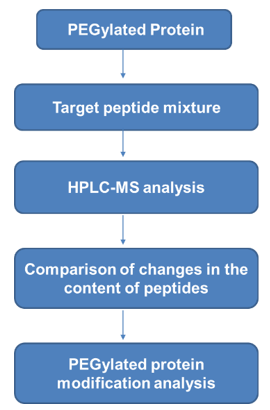PEGylated protein drugs can prolong the half-life of the drug, reduce immunogenicity, and retain its biological activity to the utmost extent. The modification site analysis of PEGylated protein is a key component of biological protein research and development analysis.
Creative Proteomics has researchers with rich pharmaceutical experience and a first-class experimental analysis platform. We are committed to becoming the most reliable biotechnology-medicine alliance partner to provide customers with high-quality and professional analysis services. We will use professional proteomics analysis methods to ensure that you get high-quality product analysis reports. The identification and analysis of PEGylated protein in biopharmaceuticals is one of the important components of protein drug quality control and biosafety analysis. In particular, the ICH Q6B guideline requires the provision of protein modification site analysis information for protein drugs. We will provide you with polyethylene glycol site modification identification services around the ICH guidelines (especially ICH Q6B) and the US FDA issues 'Points to Consider' document.
We Can Provide but Not Limited to:
- PEGylation sites & PEGylation heterogeneity identification
- Analysis of acylation modification of N-terminal amino group
- Analysis of acylation modification of lysine side chain amino group
- Analysis of alkylation modification of N-terminal amino group
- Carboxyl modification analysis
- Sulfhydryl modification analysis
- Glycosylation analysis
- Phosphorylation analysis
- Disulfide bridges & free sulfhydryl groups analysis service
- Deamidation and Oxidation analysis
- Site-specific modification analysis based on amino group protection
- Site-directed modification of non-polar amino acids
- Site-specific modification analysis of glycosyl groups in glycoproteins
- Polyethylene glycol heterogeneity analysis
- Analysis of the proportion of polyethylene glycol modified sites
Technology Platform of PEGylated Protein Modification Analysis Service:
Creative Proteomics can obtain high-quality and accurate analysis of PEGylated protein modification through amino acid analysis, Edman degradation method, tandem mass spectrometry, matrix-assisted laser desorption/ionization time-of-flight mass spectrometry (MALDI-TOF-MS), etc.
We provide the following analysis methods:
Identification of modified sites of polyethylene glycol
1) PEG derivative analysis method
The amino acid (Met-Nle or Met-β-Ala) activated by succinimide ester is used as the linking bond, and the conjugate can be cleaved by BrCN to obtain the protein linked to Nle or β-Ala by amino acid analysis or Edman degradation method. Determine the Nle or β-Ala attachment site, and then determine the PEGylation site.
2) Mass spectrometry
The PEG-modified superoxide dismutase (SOD) was hydrolyzed, and its peptide map was measured by tandem mass spectrometry to determine the modification site and degree of modification.
3) Protease enzymolysis
The PEGylated protein products in the solution were digested with trypsin under the same conditions by external standard method, and the peptide mixture was analyzed by HPLC-MS. The missing peptides were the modified PEG sites. To prevent the sequence of the peptides that are restricted by their conformation and cannot be cleaved by trypsin, compare the content of the polypeptide in the protein digestion products before and after coupling to obtain the information of the protein PEG modification site. The specific workflow is as follows:

4) Matrix-assisted laser desorption/ionization time-of-flight mass spectrometry (MALDI-TOF-MS)
Use MALDI-TOF MS technology to analyze the qualitative and quantitative analysis of polyethylene glycol modified products of high molecular weight polyethylene glycol modified proteins.
Detection of modification degree of polyethylene glycol
1) Fluorescent labeling
The protein is modified with a PEG molecule with a bright amino acid attached to one end, and the number of PEG coupled to the protein is calculated by measuring the content of these markers, so as to obtain the analysis of the degree of polyethylene glycol modification of the polyethylene glycol protein.
Advantages of PEGylated Protein Modification Analysis Service:
- Short time-consuming: The service adopts standardized analysis methods and high-efficiency data analysis software. At the same time, it adopts a fast and convenient sample processing procedure, which can greatly reduce the analysis time for PEGylated protein modification.
- High sensitivity: The analysis method combines fluorescent labeling and mass spectrometry combined analysis method to achieve high sensitivity when analyzing polyethylene glycol modified sites.
- High accuracy: Mass spectrometry can obtain high-precision analysis information of polyethylene glycol sites.
- High-throughput: We can provide a variety of complex PEGylated protein modification customized services. In this service, the types of PEGylated proteins that can be identified are complete, and we can provide customers with guaranteed after-sales service.
- Rapid turnaround time: 5-7 days to provide complete analysis report.
- Customized service: We can provide you with tailor-made services according to your needs, and you can choose the analysis plan you need.
Creative Proteomics researchers can provide you with detailed experimental analysis programs, complete and comprehensive PEGylated protein modification analysis reports and other bioinformatics analysis reports. We insist on focusing on customer needs and assist biopharmaceutical companies to better complete research projects in terms of technology and analytical solutions to accelerate the marketization of their products.
References
- Abdellatif AAH. Identification of somatostatin receptors using labeled PEGylated octreotide, as an active internalization. Drug Dev Ind Pharm. 2019.
- Mero A, Spolaore B, et al. Transglutaminase-mediated PEGylation of proteins: direct identification of the sites of protein modification by mass spectrometry using a novel monodisperse PEG. Bioconjug Chem. 2009.






